The Google Pixel 3a XL Review: Does Mid-Range Make Sense?
by Andrei Frumusanu on June 27, 2019 8:00 AM EST- Posted in
- Mobile
- Smartphones
- Snapdragon 670
- Pixel 3a
- Pixel 3a XL
Display Measurement
The display on the Pixel 3a XL is well specced for its range and price; the fact that Google opted to still employ an OLED panel rather than adopting a cheaper LCD does very well for the value of the new phone and does manage to differentiate itself from a lot of other devices from the competition, although we have seen more widespread adoption of OLED even in this tier.
Both the Pixel 3a and Pixel 3a XL display panels are exclusively made by Samsung and use Samsung DDICs, which is a safe choice given the display issues we’ve encountered on past LG-sourced Pixel devices.
As always, we thank X-Rite and SpecraCal, as our measurements are performed with an X-Rite i1Pro 2 spectrophotometer, with the exception of black levels which are measured with an i1Display Pro colorimeter. Data is collected and examined using SpectraCal's CalMAN software.

In terms of display brightness, it’s relatively on par with the manual maximum brightness levels we’ve seen from many OLED devices, with the Pixel 3a XL falling in at ~410 nits in the Natural display mode.
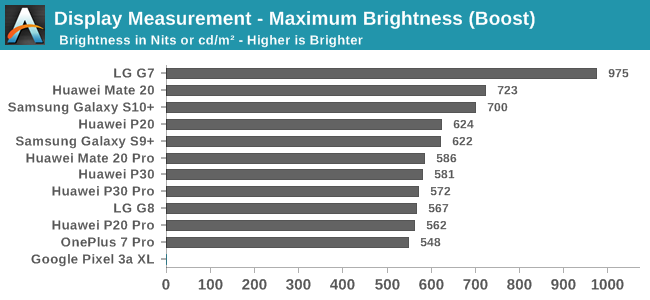
Unfortunately there’s no boost mechanism available, and the auto mode doesn’t have any high ambient brightness mode.
In terms of display modes, Google continues on with what we’ve seen in the Pixel 3. We have the “Natural”, “Boosted” and “Adaptive” modes. The phone by default comes in the Adaptive mode which is a highly saturated inaccurate mode. It’s been hinted to me that the reason Google opts to deliver the phone in this mode is because of pressure such as Samsung also having defaulted to saturated colours; however with this year’s phones this is no longer the case as the Korean vendor opted to ship it with accurate colours out-of-the-box, so I hope later this year Google will follow up doing the same in the Pixel 4.
The Natural mode is the phone’s most accurate colour profile and is colour managed, with accurate sRGB and Display P3 gamut targets. We’ll be remaining in this mode for our testing.
Starting off the greyscale accuracy tests, we see that the Pixel 3a XL does extremely well in the colour temperature department, achieving near perfect whites with an average CCT of 6428. The phone’s colour temperature seems to remain steady across brightness levels, although at lower brightness settings it does get a bit warmer towards 6100K. Nevertheless the differences are not perceptible and it’s a great result.
Minimum brightness falls in at 2.4nits, which is a little bit brighter than other phone’s minima, but it’s still adequate enough for evening low-light reading. As mentioned, the maximum falls in at 410nits at full-screen white with no further boosting. I did note that the screen does have APL brightness scaling, and did measure it go around 500 nits when showing lesser picture levels.
I did find some issues with the gamma: Oddly enough at 100 APL the results are near outstanding, and the 3a XL is able to achieve leading results with an almost perfect gamma as well as a greyscale dE2000 of 0.71.
The issue is, when going towards lower APL patterns, this behaviour falls apart and the panel clearly misbehaves in terms of luminosity and we’re seeing a gamma of 2.4-2.5.
 Greyscale 200nits APL100 SpectraCal CalMAN
Greyscale 200nits APL100 SpectraCal CalMAN Greyscale 200nits APL65 SpectraCal CalMAN
Greyscale 200nits APL65 SpectraCal CalMAN

Overall, because of the gamma issue, the phone ends up with a dE2000 of 2.21, which is still quite good. Please do keep in mind the gamma issues here as we’ll shortly see more drastic effects in the latter Gretag-MacBeth test.

Natural Mode - sRGB - SpectraCal CalMAN
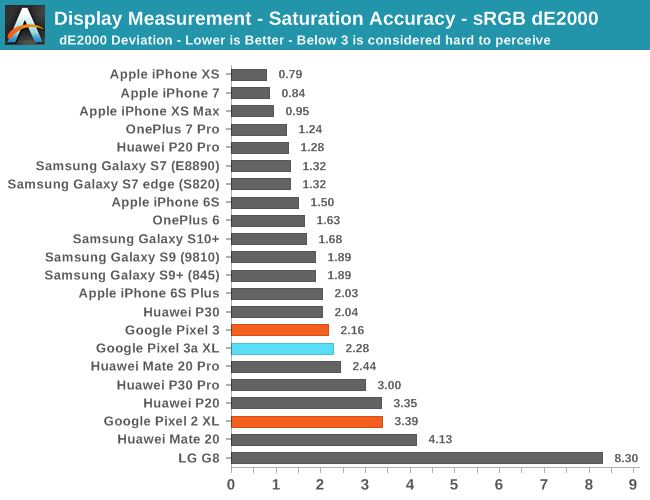
Saturation accuracy for sRGB content is ok with an overall dE2000 of 2.28. The issue here is that the reds and blues are slightly undersaturated at all levels, which does reduce the gamut coverage of the panel.
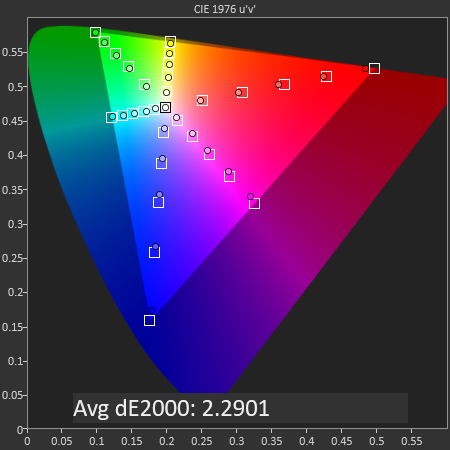
Natural Mode - Display P3 - SpectraCal CalMAN
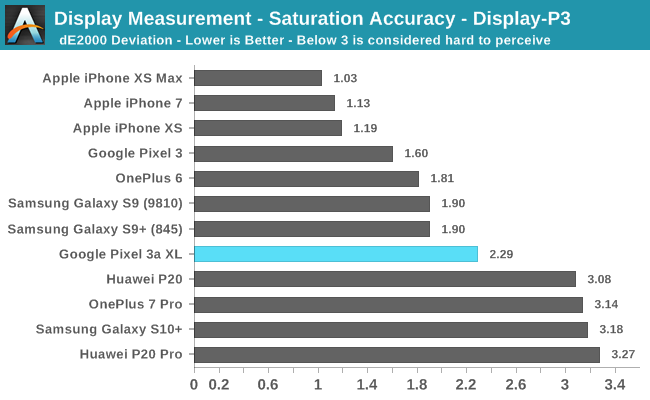
Display P3 content showcases the same issues of being under-saturated in the red and blues, also not quite reaching the maximum gamut of the colour space in this regard. Nevertheless, it’s a relatively errors are relatively linear so other than a slight under-saturation you will not see too major errors in terms of chromacity of colours.
In the Gretag Macbeth colour test with commonly found tones we see some of the larger issues of the Pixel 3a XL’s calibration:
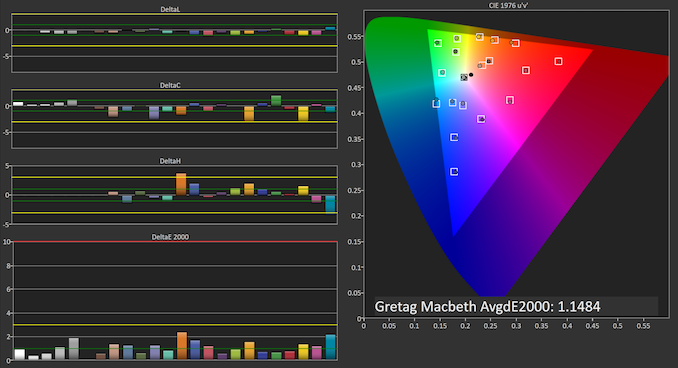
GMB Natural - Sequentual APL100 SpectraCal CalMAN
If we’re testing the colour patches sequentially at APL100 we are seeing some outstanding results with extremely accurate colours, with only a few tones being off-mark. The dE2000 here would have ended at 1.14 which is top-of-the-line.

GMB Natural - Sequential APL65 - SpectraCal CalMAN
If however we test the pattern on a lower fixed APL (as we usually do), then we’re seeing some large errors in terms of luminosity, and we’re seeing the effects of the larger than optimal gamma we discovered before. Here the dE2000 of the GMB test falls in at 3.06, slightly above the limit of what should be acceptable.
However I wasn’t quite satisfied with my results as I noted that the phone was not actually behaving correctly even with fixed APL patterns. I noticed that luminosity also is highly dependent on the pattern window size, meaning the panel scales not only scales with APL, but also based on the % of pixels which are white. This causes quite a headache as it’s not actually possible to sequentially display automated patterns while keeping the luminosity constant.
I went ahead and just transferred our GMB colour patches onto a single static image and measured each square thanks to the small read head of the i1Pro.
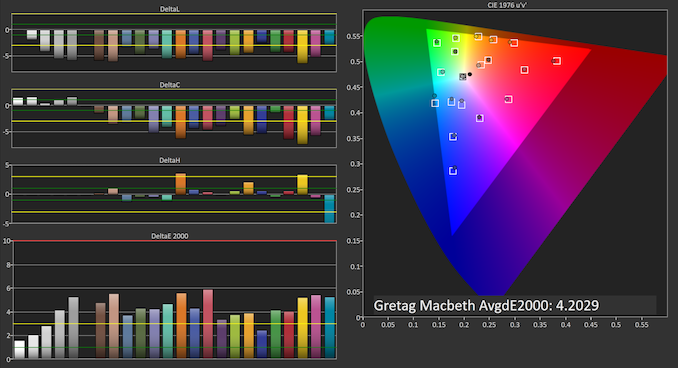
GMB Natural Side-by-Side Patches SpectraCal CalMAN
When measuring things in this manner, we actually see that things are actually worse than with the automated fixed APL method.
What’s actually happening here seems all too obvious: Google did very evidently calibrate their panels, however they did a massive mistake in their methodology. Either the engineers calibrated the display with full-screen and varying APL patches, which would pretty much explain the near absolute perfect results we’re measuring on the 3a XL, or the APL mechanism was enabled after the colour calibration took place. In my view I would point out to the former as the results are too perfect.
Unfortunately this does have a larger impact on the colour accuracy of the screen as we end up with an effective gamma of 2.5-2.6, and as seen in the final comparison picture colours are far too dark in relation to white, resulting in artificially more contrast.

Unfortunately this behaviour was actually also present on the Pixel 3 – however not quite with such a large difference. I do very much apologise to our readers for not catching this mistake last year, and in the future I’ll keep a closer eye on such behaviour. I’ve re-measured the Pixel 3 and it does very much negatively impact the accuracy score.
As for the Pixel 3a XL, this also does have a bad impact as the phone ends up with a dE2000 of 4.20 in the GMB chart.
Overall Display Conclusion: Still Good, Albeit Obvious Miscalibration
Overall the Pixel 3a XL display is still a good display. Having an OLED panel at this price category does remain a large advantage for the phone. Viewing angles and constrast are excellent, and while it doesn’t compete with flagships for brightness, it’s still very excellent and results in good sun-light legibility. The panel quality is excellent and the Samsung-sourced unit doesn’t exhibit any issues previously encountered on LG-sourced panels, and characteristics such as base power consumption are good.
It’s a pity for the colour calibration: Google very obviously paid attention to this and attempted to give the phone accurate colours, but they made a huge mistake in their methodology which results in the phone effectively having very inaccurate gamma and colour luminosity in actual content, resulting in darker-than-should-be colours.


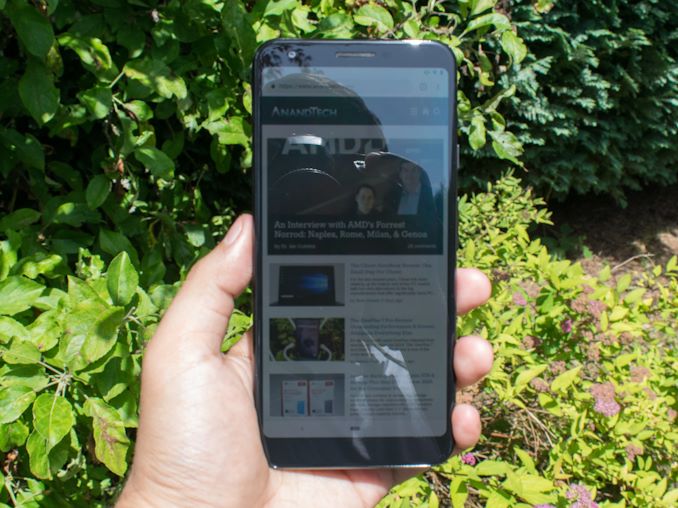
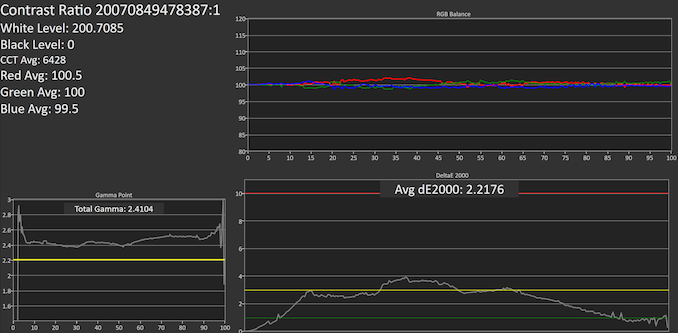


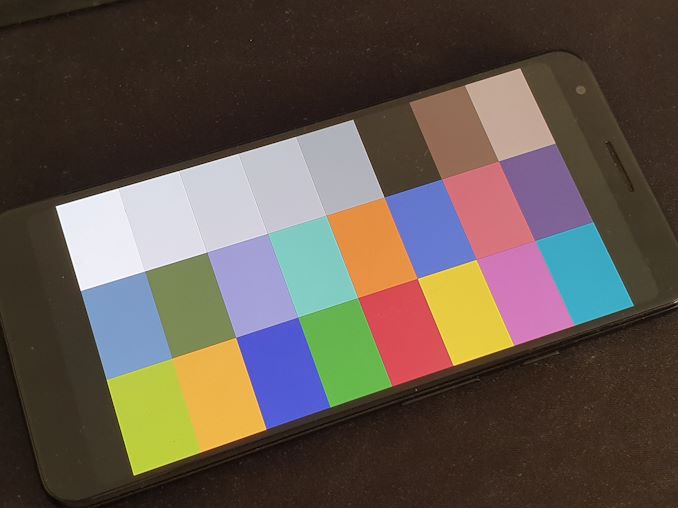









94 Comments
View All Comments
RSAUser - Thursday, June 27, 2019 - link
/looks at phone without a screen protector that's over 2 years old without any scratchesWhat are you talking about? Depends on the person.
Oyeve - Thursday, June 27, 2019 - link
And most people are idiots who don't care about sound quality. Thats why there are so many bitch-buds on the market. For those of us who actually own very good headphones we all know blue headphones are garbage. We want loud high quality sound and BT does not come even close. I use a Fiio amp and good wired headphone on all of my phone because BT sucks.grant3 - Thursday, June 27, 2019 - link
The idea that plastic is "more prone to dents & scratches" than aluminum is laughable.The idea that plastic is "less durable" than glass is laughble.
Yet this author is happy to make such a claim with literally no experience let alone proof to support his assertion.
fred666 - Friday, June 28, 2019 - link
plastic is the superior choice because it is light, lets the magnetic waves through and absorbs (some of) the shock instead of breaking like glass or transmitting it to the components like metal.MadManMark - Monday, July 1, 2019 - link
I know, I consider the plastic a feature, not a compromise!deskjob - Thursday, June 27, 2019 - link
I must be an unicorn. I stopped using a case with the OG pixel. Haven't looked back. Maybe I am more careful or less clumsy when it comes to gadgets. I've dropped it once from about 4ft onto sidewalk, fortunately only got minor chip around one corner. Otherwise the no scratches anywhere. So yeah that info matters to me.Also headphone jack is one of the main reasons I am even considering the 3a XL. True, most people don't care because they don't care about sound quality in general. That's cool. There are still some people out there who do care about sound quality. I use a bluetooth speaker for podcasts, but wired for anything else.
nucc1 - Sunday, June 30, 2019 - link
You get the case for that once or twice a year drop just like you. This way, you're far less likely to need repairs and it's more freedom from worrying about your phone.Without a case, the phone can start looking really worn out after a year and it might make you replace it sooner than you have to.
MadManMark - Monday, July 1, 2019 - link
You're not alone. If people like to spend $1000 on a phone and then wrap it up in quasi-bubble wrap to make it chunky, that's fine. I like to buy phones for just a few hundred (due to their trade-in program this one cost me $210 net, after I bought an iPhone 6 to trade in) and then just USE it. I put on a screen protector, but as far as a case: if there is a scratch on the plastic back, there is a scratch. It doesn't affecgt anything, and I'll be upgrading in a few years again anway. Who is always looking at the BACK of their phones in the first place?grant3 - Friday, July 5, 2019 - link
I think the screen on the 3a xl is probably stronger than the body.I bought a case for mine because i drop it a lot, but for the last few years people have been starting to convince me the screen protector is not really needed.
melgross - Thursday, June 27, 2019 - link
Very high quality polycarbonate? I’ve done extensive work in materials; wood, metal and plastic. I’ve used numerous brands of polycarbonate. They are all the same.The differences between utilization is what you’re noticing. Differing thicknesses, differing tapering of the thickness over the sheet used in the body. Differing curves, giving different impressions as to strength and resistance to indentation from pressure, etc.
The different textures also leave thoughts as to quality. But the plastic is all the same. Pretty much exactly so.
One of the benefits is that there should be no dents due to banging the device, which is the opposite to what you have with the necessarily thin metal used, which is strong, but a dent magnet, in many designs, particularly in cheaper devices. Polycarbonate, while like every other plastic, is soft, in fact, it’s noticeably softer than the otherwise much more easily broken acrylic. Both can have anti scratch coating applied, but that substantially increases the cost, and isn’t used with textured finishes. Besides, it wears off on devices that are constantly being fondled by their owners.